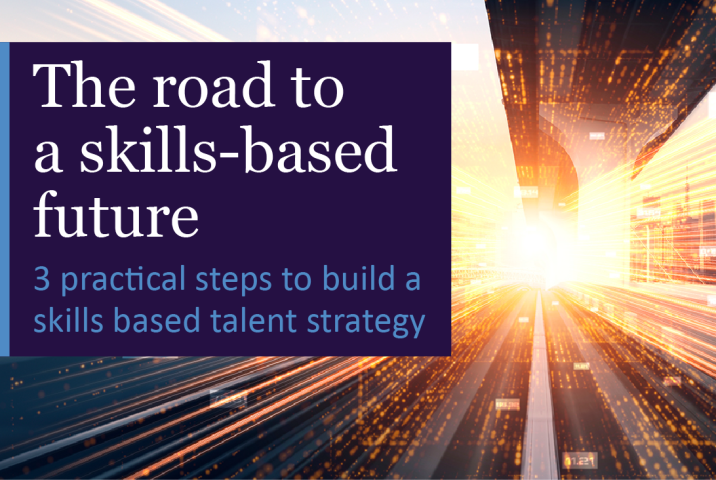Liberating our talent to prepare for all possible futures


Maggi Evans is an experienced consultant with international experience across a wide range of sectors, and co-author of From Talent Management to Talent Liberation, which will be published in December 2020.
To create nimble, responsive and resilient organisations, we must reframe talent management as talent liberation, writes Maggi Evans.
We’re all familiar with the emerging changes in the workplace – the so- called Fourth Industrial Revolution, the digital age. This is bringing fundamental shifts in the nature of work and working life, with many organisations transforming their operating models, building agility into their structures, localising decision making and simplifying processes.
It certainly brings a challenge for HR: having spent decades driving efficiency through consistency and planning, we are having to rethink and reimagine how we can add value to a different kind of organisation. Central to this is finding ways to balance the need for responsive, short- term tactics with the need for long-term strategy and planning.
It’s a classic wicked problem; there is no one right answer, no clear starting point and many separate issues are intertwined or contradictory, making it difficult to know where to start. Talent management is perhaps at the epicentre of this wicked problem – trying to resource rapidly changing current needs while also developing the capability for a shifting future (all within a limited budget).
We need to develop adaptive talent strategies.
Stuck in a time warp
Many of our current talent tools have their roots in the 1950s, a period with greater predictability; a time when five-year succession plans made as much sense as 10-year strategic plans. The way most organisations ‘do’ talent management is stuck in this time warp and is not fit for purpose in the current age. We therefore need to overhaul our short- and long-term talent processes, and the way we perceive talent management. We need to think about ‘talent liberation’ instead of talent management. So, what can we do?
In the short term, we need to develop adaptive talent strategies. These are approaches with sufficient flexibility to enable us to respond to immediate needs, to scale up or down, to redeploy and refocus. This is something we’ve become more skilled at with the onset of furlough and other government schemes to support employment during the coronavirus pandemic.
There are four elements to this:
- visibility of short-term available talent (within the organisation and outside it)
- rapid reporting to track business needs and identify gaps
- simple processes to fill gaps, reskill, upskill, redeploy
- a cultural element that embraces flexible resourcing and encourages the transparency and collaboration required for success
This ‘real-time’ responsive approach is a challenge to many of our traditional methods of workforce planning, particularly in large and complex organisations. However, the model used in professional services is one from which many organisations can learn. These firms are used to operating in an uncertain world, unsure which contracts will be secured and exactly which skill sets will be in demand.
They have flexible team structures, set up for each project, with the people-management role separated from the task-management role. People are a shared, business-wide resource rather than ‘belonging’ within specific structures, so are free to move between geographies, customers or business areas.
Leaders and managers have the skills to inspire, motivate and develop people in frequently changing teams. If they don’t have enough people on the ‘bench’ for a project, they will resource externally, or rapidly develop internal people to fill the gaps. Similarly, retail has, for many years, had flexible resourcing, with weekly sales and seasonal trend data driving decisions about rotas and shifts. For professional services firms and retailers, this flexibility is an essential element of their business model – and it’s a feature from which many other organisations can learn as they explore how to develop greater agility.
As soon as we plan for just one future, we limit our preparation for the unexpected and with it, our ability to flex.
Considering all the possible scenarios
Looking through the long-term lens, we must start by considering the strategic aims of the organisation and possible scenarios for how the organisation might evolve and grow. For each scenario, it is possible to identify potential organisational priorities and risks that the talent strategy needs to address; for example, how to ensure access to critical technology skills, how to resource expansion into new geographies, how to acquire and integrate new businesses successfully.
A strategy can then be built to show how to respond to each scenario – factoring in possible changes in technology which may mean that some roles are more/less important. Inevitably, this is based on a series of ‘best guesses’. But as energy company Shell found through its groundbreaking work on scenario planning in the 1960s, the value comes less from predicting an actual future and more from recognising that the future is not set, from being prepared to succeed in a range of possible futures.
As soon as we plan for just one future, we limit our preparation for the unexpected and with it, our ability to flex. As with the short-term talent approach, organisations will only succeed in this if they look at culture as well as process. There are four particularly important cultural themes.
Organisations need to recognise the value of diverse skills and experience. This might even mean bringing in ‘disruptive talent’. Firms require access to fresh perspectives. An organisation of clones is unlikely to be able to respond or adapt well to change.
Greater transparency is essential. This means having open conversations about possible scenarios and about the skills and experiences that will be most valued, involving feedback and support to enable people to develop these skills.
Businesses must work in partnership with talented people, whether staff are employed, ‘borrowed’, temporary or permanent. We need to engage with our people to find the ‘sweet spot’ between their wants and needs and those of the organisation. This requires thinking about them as stakeholders within the talent agenda. Instead of leaving their voice out of talent plans and decisions, we should be educating and empower our people to be proactive in managing their own careers, encouraging job crafting, motivating and supporting them to be their personal best. Through this, we can help everyone to perform well and thrive, attracting and accessing the broad range of talented people we need to safeguard success.
The approach must be owned by the HR function. These are business-critical issues and all leaders need to lean in, building new skills, challenging current approaches and embracing agility in how work happens.
A fundamental overhaul
These ways of thinking represent a fundamental overhaul of talent management. As HR professionals, we need to let go of our historical approaches and reshape the conversation, finding new ways to drive competitive advantage and manage risk, and so creating organisations that are nimble, responsive and resilient – where talent is liberated rather than managed.
In my experience, leaders are open to this change; they can see that current approaches are not bringing the benefits they need. Now is an ideal time to introduce new language into our talent conversations, to ask about future scenarios, to challenge established practices around secrecy and to invest time in developing a positive talent culture fit for the future.
Originally published in Catalyst Magazine The 'Dexterity' Issue.
More articles
AMS launches Ethical AI in Talent Board
AMS launches Ethical AI in Talent Board to ensure fair, unbiased AI use in recruitment. Experts will guide ethical AI adoption across the talent lifecycle.
The road to a skills-based future
Learn how to reframe talent for the future. Don’t miss the opportunity to unlock organizational potential and meet tomorrow’s challenges, starting now.
What is Contingent Staffing, and What Are the Benefits?
Learn what contingent staffing is and explore its benefits, from flexibility and cost savings to access to specialized skills.

Start your journey to True Workforce Dexterity.
Discover how we can help you build, re-shape and optimise your workforce.
Talk to us





